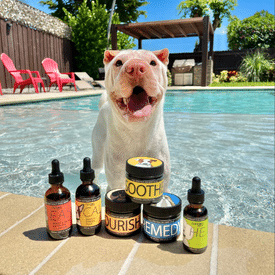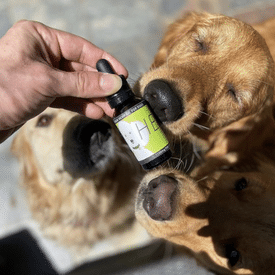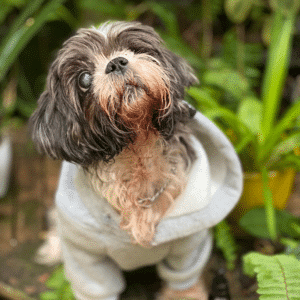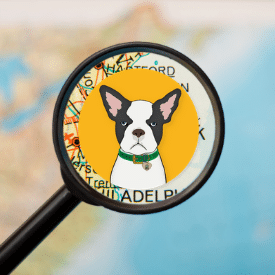Hurricane Prep for Pets

Hurricane season in the Atlantic runs from June to November — and although we can track hurricanes as they form, they can still be unpredictable and being prepared can be the difference between life and death. In an emergency, your pets are even more dependent on you, and having a hurricane preparedness plan for your pet is vital. So let’s go over some tips for hurricane prep for pets.
Step One: Make a Pet Plan
Leaving your pets out of your evacuation plan can put you, your pets, and first responders at risk. Although hurricanes often come with fair warning, disaster can strike at any time and without a plan in place, things can quickly become dangerous. So before hurricane season starts, make sure you have plans in place for you and your pets. It’s also best to have plans for multiple situations, like riding out a storm at home, or needing to evacuate. Remember if it’s not safe for you to stay home, it’s not safe for your pets either.
For example, my family has two plans: an evacuation plan, and a plan for riding the storm out at home. We also set parameters for when to use each plan, such as agreeing to evacuate if a storm is a category four or higher. This takes the “Should we? Shouldn’t we?” stress and anxiety away, as you’ve already agreed beforehand on what to do in each case.
When making the evacuation plan, start by researching pet friendly hotels where you can stay, or locate a pet friendly shelter in your area. A full list of pet friendly shelters can be found on BringFido. Remember: pet-friendly shelters and hotels will fill-up fast, so plan two or three backup locations. Be sure to consider routes and distance, as it may not be safe or possible to travel long distances during an emergency.
If there is no way that you can take your pet with you, plan with friends or family in safer locations about caring for your pets, or consider boarding your pet at a safe facility (like Fire Flake Farm). Although it may seem a last resort, never leave your pets home alone during an evacuation.
Make a list of the veterinarians and emergency pet clinics nearby, both near your home and near where you plan to evacuate to. Storms and evacuation can cause pets to suffer extreme anxiety and may cause them to act out, so knowing where to take them in an emergency can be a huge help.
Step Two: Make a List of Supplies
Just like you plan for your own emergency kit, consider what your pet needs to survive during an emergency. Making a list ahead of time can save time and ensure you don’t forget something important when the time comes.
- ID – Collar, tags, identification paperwork such as their pet registration or any other necessary paperwork.
- Food – Food bowl, If you feed your pet a raw diet, you may need to get Freeze-Dried pet food for emergencies, in case you loose power or don’t have access to a freezer. You should have enough food for two weeks, packed in an airtight, waterproof container.
- Water – Water bowl, and enough water to last two weeks.
- Medicine – Any medications necessary for your pet for two weeks
- Veterinary paperwork and vaccination records
- Supplements – Full Spectrum Hemp Extract and other supplements your pet normally takes and may need to keep CALM.
- Leash – Harness and leash, plus back ups, you definitely don’t want to be separated in an emergency!
- Carrier – Crate, Traveling Bags, or Carriers for each pet
- Sanitation – Cat litter, Litter Box, Dog Pads, Waste Bags, Paper Towels, Trash Bags, Cleaning Supplies
- Grooming – Shampoo, wipes, towels
- Bedding – beds, extra blankets
- Toys – Favorite toys to help with stress and give them comfort
- A photo of you and your pet – in case you get separated
Step Three: Putting Plans Into Action
Before a hurricane ever hits, make sure that your plans are ready to implement. Be sure to already have everything needed for your plans ahead of time. Make sure pets have up-to-date collars and tags. If you become separated from your pet, this may be the only way to find them. If your pet is microchipped, make sure to update your contact information. Make sure that any and all rescue alert stickers on your home are up-to-date as well. If you are evacuating with your pet, make sure to write ‘EVACUATED’ on your rescue alert sticker to alert first responders that your pets have been evacuated with you. Remember: Never leave your pets home alone during an evacuation.
As a Floridian, I know to keep a reserve of the supplies I made on my list during step one at all times. Stores will quickly sell out of many supplies that you might not think of (like pet food, bottles of water, etc). So during the summer I know to keep extras of those items, before hurricane season begins. If a storm is coming and you haven’t had time to stock up, make sure to start as soon as you can. Fill any prescriptions for your pet and make sure that you have any supplements they may need during and after the storm. It is also recommended that you keep a current photo of your pet, as well as a description of your pet, and any of your pet’s medical records, to help in the event that you and your pet become separated.
If you plan to shelter at home, choose a safe room, away from windows and outer doors, and remove anything potentially hazardous to pets. This includes plants that might be toxic or anything your pet might find on the floor. If you have a small dog or cats, make sure that air vents are closed and small spaces where they may become trapped are concealed. Your pet may become panicked during the storm and might try to hide, so knowing everywhere they could possibly hide or get stuck can save time and energy later.
Step Four: Keep Yourself and Your Pets Calm
Hurricanes are enough to rattle anyone’s nerves, so it’s normal for you and your pets to be feeling stressed, anxious or fearful. However, it is important for you and your pet to remain calm. Remain patient with your pets both during and after the storm — the shakeup in their routine can cause a lot of stress and anxiety. When coupled with the loud sounds of a storm or the stress of evacuating, this can lead to some behavioral issues, so they need your support and understanding.

After the hurricane has passed, make sure to remain calm when you take your dog outside, and do not unleash them until you have completely surveyed the damage. Although the damage may be stressful, remember that keeping yourself and your pets safe is the most important thing.















